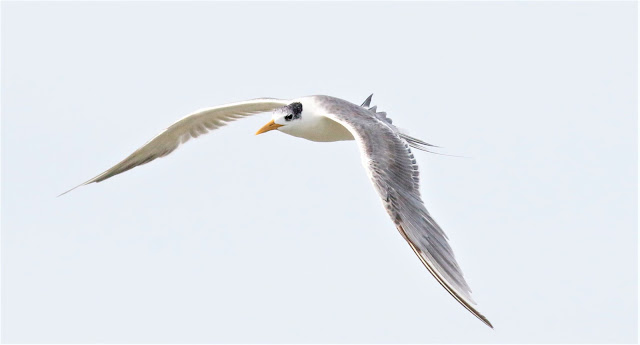Photography is mainly about beauty while birding is all about discovery. When you mixed both hobbies together, you might just get some rewarding results ! Great Crested Tern are probably one of those few terns which you do not often see at the mudflats. Despite their widespread and year round resident status as reported by some books and sites, you could just occasionally encounter this magnificent tern when they go hunting for fish near the shoreline. Although they are not really pelagic birds but i do believe they spent most of their lives offshore. Feel free to immerse yourself into some of their stunning profiles below.
Differentiating between a Great Crested Tern and Lesser Crested Tern can be quite difficult if you do not have either photos or information to compare or look at.
Here are some field marks (gathered from various sources) of a Great Crested Tern which might be handy to you.
i) Yellowish bill
ii) Slight down-curved bill
iii) Mantle dark-grey
iv) Shaggy nuchal crest
v) White forecrown
vi) Outer primary tips dark
vii) Size slightly larger than Lesser Crested Tern
vii) Size slightly larger than Lesser Crested Tern
Many of us will look at their yellowish bill as a common indicator but i can assure you that most birding experts would probably advise you that none of the above features can be used as an absolute indicator on their own. They should instead be scrutinised as a whole to form an overall picture of a Great Crested Tern.
Apparently they are quite rare in Britain and Europe.
Great Crested Tern also do "plunge diving" for their food but not from great heights like the ones executed by Little Tern (personal observation)
Currently there are just 5 subspecies which are recognised in the literature. They are as follows:
i) T.b bergii
ii) T.b enigma
iii) T.b cristatus
iv) T.b thalassina
v) T.b velox
The ones which are reportedly common in Malaysia is the Ssp T.b cristasus which are said to have dark grey above and less white on their head while T.b velox is reportedly to be the largest among the 5 Ssp and has the longest bill and far more darker. HBW Alive have added another subspecies i.e T.b gwendolence which is reportedly occur only in Australia. Having known all the above information, you might want to guess which Great Crested Tern species/sub-species do these 2 photos (below) belong to:







































